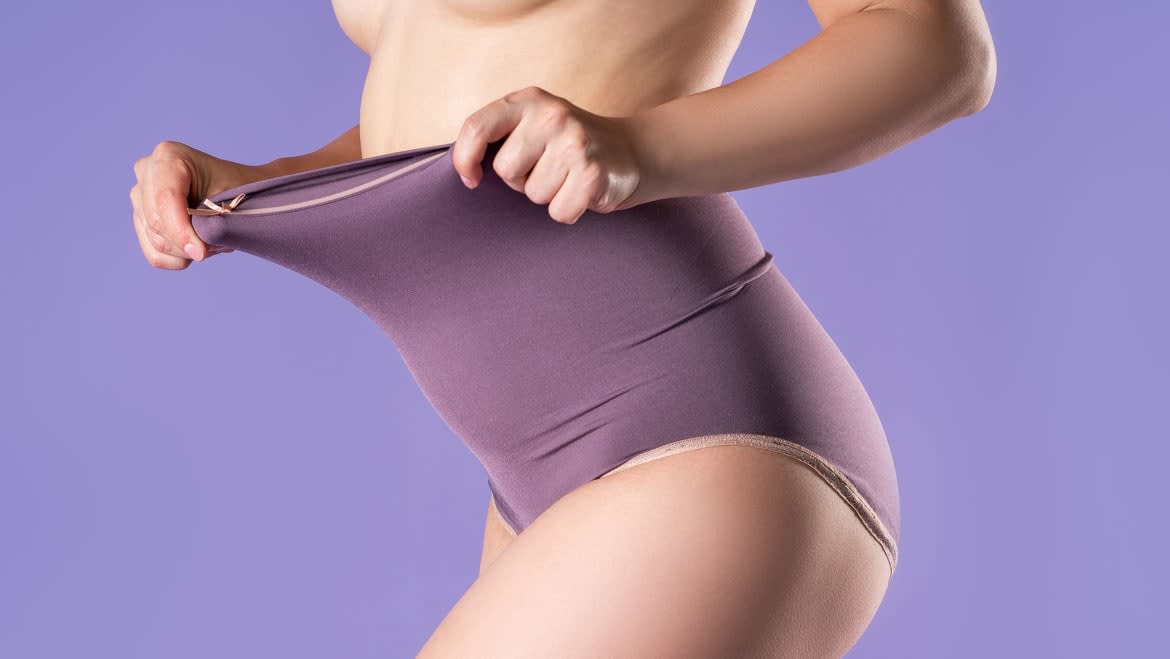Can Shapewear Survive in the Sweatpants Era?

Our wardrobe staples are changing. The continued lockdown has meant that where we used to have work wardrobes, going-out clothes, and casual wear, we’ve now been reduced to that same ratty T-shirt and leggings most days.
Yet shapewear—typically worn at special occasions, formal gatherings, dates, and other things that are non-existent right now—is holding on.
Despite women spending literally dozens of Friday nights on the couch over the past year, Spanx is making it through the pandemic better than many clothing brands. Online searches for shapewear are faltering slightly, but in comparison to the dozens of clothing retailers that have declared bankruptcy since the start of the pandemic—like J. Crew, Neiman Marcus and Century 21—shapewear has adapted to our suddenly home-based working and relaxing lives.
It’s the Great War of Kim Kardashian’s Skims Versus Spanx—but What Shapewear Do Women Really Want?
“We'll be taking the notion of comfort in clothing with us post-COVID, even when we're back out and about—going to work and socializing again—and shapewear is going to have to appreciate that new mindset,” said Elizabeth Shobert, VP of Marketing and Digital Strategy at StyleSage.
“I also think the body-positivity movement will continue its momentum and that shapewear brands will want to be careful to use language that doesn't go against that grain.”
After promoting leggings marketed as perfect for those staying home for the holidays last month, Spanx is pushing athletic wear on its Instagram page at the start of the year. Kim Kardashian West opened a new line of shapewear not long before the pandemic began and started selling maternity styles and loungewear in 2020.
Despite there being nowhere to go—or nowhere you’re supposed to go—since last March, some people have still found reason to bring out their shapewear. Whether it’s nostalgia for the days of dressing up and going out, brand loyalty or wanting to try out the new products that the industry has been developing, people are still interested.
this was the only passable photo this is us exiting 2020 (I wore spanx to the zoom party) pic.twitter.com/IQEYHdjHuB
— brennuary bones (@BonniePuns) January 1, 2021
Meanwhile, we're "ringing" in the New Year the best we know how: a onesie and SPANX! @jessicavosk pic.twitter.com/KuB5NavhEd
— SPANX (@SPANX) December 30, 2020
Mommy & daughter cozy in our @skims 🤞🏼🤍 pic.twitter.com/PcXsmm4dwk
— miri (@miriacvd) January 1, 2021
During pre-pandemic times, New York actress Jessica Vosk wore shapewear regularly for performances, tapings and almost anything work-related.
But even in the pandemic, and in fact especially during the pandemic, she’s found herself bringing them out. “Shapewear to me had always been like that little security blanket you carried around as a kid. Makes you feel better, makes you feel secure. At least, it’s always been that way for me,” Vosk told The Daily Beast.
Leggings are now prominently displayed on the Spanx website, with a phrase that has basically become synonymous with pandemic style when we’re wearing the same pants day in and day out: “comfiest, everyday go-to.”
For Vosk leggings are a key part of shapewear’s appeal currently. She recently bought a pair of black Spanx brand leggings that she is “absolutely obsessed” with.
“Will I buy more [leggings]? The limit does not exist,” Vosk said.
Los Angeles resident Brenna White has busted out her Spanx occasionally during the pandemic, even if it’s just to dress up for a take-out meal. “Even though I’m not going out, it is nice to pull on shapewear like Spanx (that I invested in) to see the curves of my body and put on outfits I used to wear,” the 34-year-old said. She hates thinking of her nicest outfits “wasting away” in the closet, and shapewear is inseparable from that.
Despite these personal stories of devotion, the pandemic has affected the shapewear industry. Online searches for shapewear are down 28% year-over-year and new shapewear styles are down 30%. “That would have to suggest to me that if that's not an outright rejection of shapewear, at the very least there's been a significant decrease in interest in shopping and wearing it [since the start of the pandemic],” said Shobert.
“With what we know about the popularity of sweatpants and leggings throughout the pandemic, it's kind of hard to envision adding shapewear to that comfortable mix,” she said.
Yet the industry’s gradual pivot away from restrictive high-rise and high-compression underclothes and towards comfort and support gives shapewear—pun intended—room to grow. Kardashian’s maternity clothes garnered enthusiasm and criticism when they were launched. Kardashian’s SKIMS shapewear line expanded sales to both the United Kingdom and the Middle East months into the pandemic.
New to the Spanx world is the Spanx Men’s line added in the first week of 2021, which includes underwear and undershirts with varying degrees of compression.
Spanx CEO Sara Blakely, who’s now worth over $600 million according to Forbes, said she’s taking the current crisis and trying to view it as an opportunity. “The narrative for all of your customers has changed, so your narrative has to change,” Blakely told LinkedIn during a podcast interview this spring. She said the company is coming up with ideas for new items, which she declined to share, and thinking about how to create a “new normal” for shoppers who are stuck at home.
“I personally will always be Team Spanx hehe,” my friend from grad school texted me when I told her I was writing this story. Shapewear is by nature a personal thing. A relationship like that—between human and articles of clothing so intimately and personally worn—can’t be easily broken. We dream of the post-pandemic time when it returns to help us feel fabulous on a night out. And until then, it can stay the trusted friend that helps us relax at home.
Get our top stories in your inbox every day. Sign up now!
Daily Beast Membership: Beast Inside goes deeper on the stories that matter to you. Learn more.

